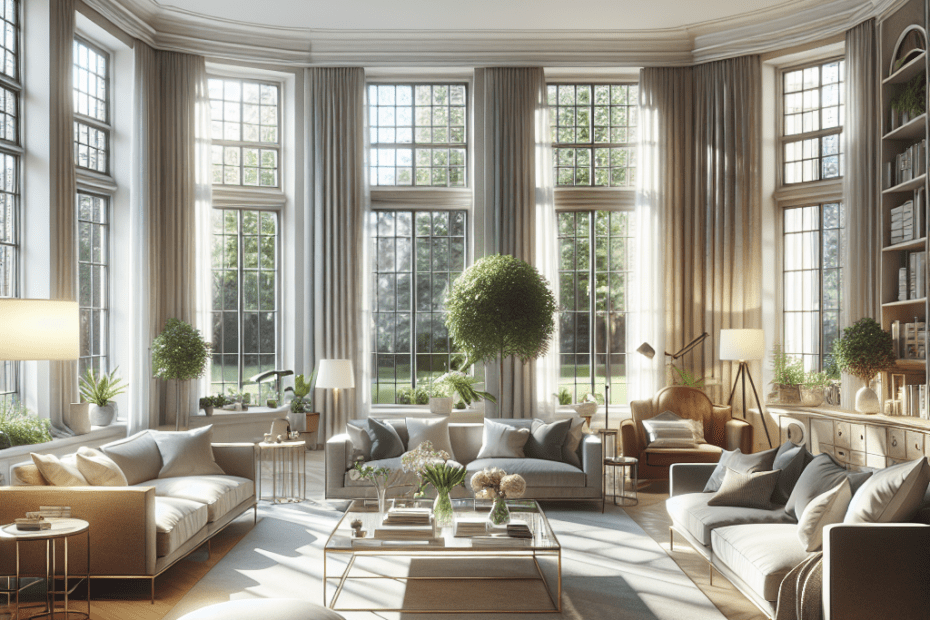“`html
Exploring the Best Furniture Layouts for Rooms with Multiple Windows
Rooms with multiple windows are a unique design feature in homes, offering abundant natural light and views. However, they also pose a challenge for many homeowners as they attempt to find the best furniture layouts to maximize space and function. By examining various strategies and understanding how each piece interacts with the room, anyone can turn a multi-window space into a harmonious and aesthetically pleasing environment.
Understanding Multiple Window Room Layouts
Rooms with several windows offer numerous possibilities for creating vibrant and airy spaces. According to a study by Design Theraphy, nearly 62% of people cited natural light as an essential feature in their preferred living spaces (Source). Multi-window rooms meet this desire, yet determining where to place furniture without obstructing views requires thoughtful planning.
Strategies for Multiple Window Room Layouts
There are several strategies they can employ to enhance the beauty and functionality of rooms that feature multiple windows. Key among them is understanding how different furniture arrangements can integrate well with available natural light.
| Strategy | Description |
|---|---|
| Floating Furniture | This involves placing furniture away from the walls and creating cozy conversation areas without blocking windows. |
| Optimizing Symmetry | Balancing furniture on either side of a central window can enhance symmetry and visual appeal. |
| Embracing Low Furniture | Using low furniture pieces ensures that the light flow remains unobstructed, maintaining openness. |
| Incorporating Multi-Purpose Furniture | Integrating pieces like benches or ottomans around windows for seating or storage boosts function without cluttering. |
| Focusing on Focal Points | They can arrange furniture to highlight a focal point, like a window framed with stunning curtains or a picturesque view. |
Floating Furniture
Floating furniture is the perfect way to create a dynamic space that highlights both the room’s features and its cozy, intimate settings. Furniture such as sofas and tables can be strategically placed to form distinct areas without disrupting natural light flow or window scene.
Optimizing Symmetry
By placing matching furniture on each side of a central window, sets of armchairs, bookshelves, or side tables can produce a balanced, visually stimulating layout. This approach is excellent for creating a sense of order and calm, drawing the eye to a single focal point in the room.
Embracing Low Furniture
Choosing low-profile furniture allows them to maintain the open, airy feel that multiple windows offer. Low-backed chairs, futons, and coffee tables ensure the room remains connected to the outdoors, with wide, unobstructed vistas as the backdrop.
Incorporating Multi-Purpose Furniture
Multi-functional furniture ensures a room remains spacious without compromising on comfort or utility. Benches with built-in storage, ottomans that double as coffee tables, and fold-out seating options offer flexibility and meet multiple needs while harmonizing with the room’s design.
Focusing on Focal Points
In rooms with numerous windows, choosing a focal point other than the windows themselves can bring more character into the space. Arranging seating to focus on a significant window view or a complementing piece of art can make the room visually striking without detracting from the window appeal.
Key Takeaways
- Use floating furniture to create cozy, intimate areas without blocking windows.
- Optimizing symmetry with balanced furniture arrangements enhances visual appeal.
- Low-profile furniture helps preserve the openness of a room with multiple windows.
- Multi-purpose furniture integrates function and style, keeping spaces uncluttered.
- Highlighting focal points besides windows helps maintain aesthetic harmony.
FAQ
Q1: What are the benefits of floating furniture in a room with multiple windows?
A1: Floating furniture creates distinct areas within a room, allowing natural light to flow without obstruction and promoting cozy conversational settings.
Q2: How can symmetry be achieved in multi-window room layouts?
A2: Achieving symmetry involves placing matching furniture on each side of a central window, such as armchairs or side tables, to create a balanced layout.
Q3: Why should low-profile furniture be considered for rooms with multiple windows?
A3: Low-profile furniture helps in not obstructing the natural light, maintaining the spacious and open feel of the room while connecting indoors with outdoors.
Q4: What role does multi-purpose furniture play in room design?
A4: Multi-purpose furniture maximizes utility and function without cluttering a room, such as storage benches and fold-out seats, enhancing flexibility.
Q5: How can one create a focal point in a room with multiple windows?
A5: Establishing a focal point with art, specific furniture arrangements, or certain window views can add character to the room without overshadowing windows.
“`
